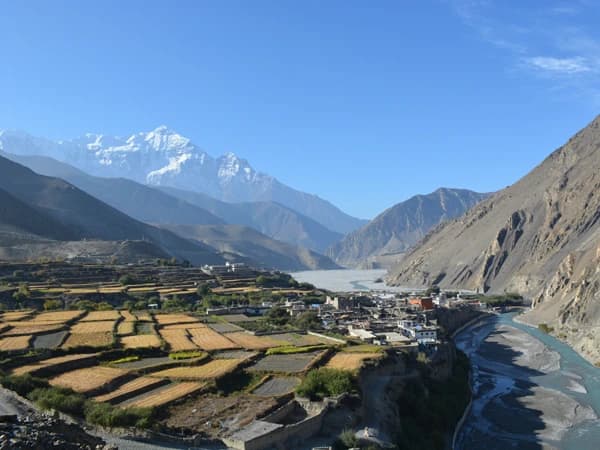Everest Base Camp Trek Weather & climate
Winter: November to February is directed by the southward migration of the northern side of the equator brings high breezes, cold temperatures, and once in a while substantial snowfalls. Winter can be an extraordinary time for trekking as the groups endeavoring to maintain a strategic distance from the virus get out. Day temperatures are agreeable and radiant skies by and large win despite the fact that it can get well beneath solidifying during the evening.
Spring (pre-Monsoon): March until the beginning of the Monsoon is one of the perfect seasons to trek. Rain is rare and day temperatures are warm. Bunch of trekkers and climbers are seen outside in shirts in this season.
Monsoon: The late spring climate (June to Sept) is impacted by the Indian Monsoon, which brings visit precipitation and overcast days. You may discover isolation amid this time yet mists and rain commonly darken the pinnacles and it is anything but a decent time to visit.
Fall (post-Monsoon): The Fall season from the end of the Monsoon until the point when temperatures get cold in December is an extraordinary time for trekking with sunny weather in the morning and agreeable temperatures.
We don't suggest travel to the region between June and September once the rainstorm sets in as commonly shady climate and rain cloud the pinnacles and If you may be fortunate then you may see the Everest.
Best time to visit Everest Base Camp Trek
There are two trekking seasons. The best time to trek to Everest Base Camp is pre-storm (February, March, April, and May) and post-rainstorm (late September, October, November, and December). It is conceivable to influence the adventure in February and early September, yet we to incline toward the above for our treks into Everest base camp. My undisputed top choices are March, late October, and November.
You can trek to Everest Base Camp in January and February however, it tends to be exceptionally chilly higher up (- 20C/ - 4F to – 30C/ - 22F) and it can dump snow on the trail whenever of year. On the off chance that you are anticipating trekking to Everest Base Camp in these months, you are certainly going to require more opportunity for climate delays. Climate conditions can be all the more difficult in these winter months.
Everest Base Camp Trek in the off-season
Trekking in the off-season isn't so acclaimed in Nepal. One of the significant motivation to abstain from trekking in the off-season is the down pouring storm. The rain causes different issues which can be a major obstacle while trekking in the off-season.
In any case, it likewise does not imply that trekking is totally inconceivable amid the off-season. The off-season for trekking begins from June to August which is the ideal opportunity for a rainstorm in Nepal. The northern Himalayan parts of the nation get a little level of precipitation while contrasted with the southern Terai part of the nation.
Trekking at the Everest Base camp can both be charming and cerebral pain amid the off-season. The flights are not pressed like the peak seasons. Likewise, you get the convenience at an exceptionally less expensive cost in the offseason like July and August.
You have to get ready extremely well on the off chance that you are wanting to go trekking in the off-season. You can't be oblivious about pressing up appropriate riggings and frill on the off chance that you are trekking in the off-season.
Chances of mountain sickness
As you will approach the stature of 5643 meters high, the oxygen level will decay with the expansion in height. This expansion in height with a decline in oxygen level outcomes in intense mountain disorder to numerous trekkers. You will begin feeling sickness, tipsiness, migraine, and weakness.
This is the intense mountain infection which happens with the sudden increment in height. This is the manner in which your body is educating you that it is getting less measure of oxygen than required. The consequence of intense mountain infection can be lethal and even slaughter you.
In any case, you don't have to stress as you will experience acclimatization at specific height to enable your body to modify the rise and circumstance. Consequently, your body will bite by bit increment the quantity of red platelets to adjust the diminished measure of oxygen in the atmosphere.it is encouraged to find out about intense mountain disorder appropriately before going for the trekking.
Tips for a successful trip in the Off-season
On the off chance that you are looking for group free walk, the off-season is the profoundly prescribed time to go to find Everest trekking area. Going amid the off seasons isn't profoundly prescribed as the climate is very cruel.
The Monsoon season enduring among June and late August, and the winter season enduring among December and February are typically not the best occasions to travel Everest trekking area Nepal. On the off chance that you intrigued to know the storm and winter in the Himalayas locale, you are welcome.
Trekking Everest base camp amid summer or amid Monsoon which falls on June to August may be influenced by rain. Yet at the same time, trekkers go to trekking Khumbu locale in June, July, and August months. These months there is no residue in the sky. The significant fascination of this season is the unfathomable association between rain, cloud, and mountain, some time conceal some time progress toward becoming perfectly clear. December is the start of winter exceptionally cold yet offers extremely incredible Mountain View.






